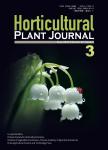Diversity of Sex Types and Seasonal Sexual Plasticity in a Cucumber Germplasm Collection
Diversity of Sex Types and Seasonal Sexual Plasticity in a Cucumber Germplasm Collection作者机构:Institute of Vegetables and Flowers Chinese Academy of Agricultural Sciences Key Laboratory of Biology and Genetic Improvement of Horticultural CropsMinistry of Agriculture
出 版 物:《Horticultural Plant Journal》 (园艺学报(英文版))
年 卷 期:2015年第1卷第2期
页 面:61-69页
学科分类:09[农学] 0902[农学-园艺学] 090202[农学-蔬菜学]
基 金:supported by grants from the National Natural Science Foundation of China(NSFC)project(31171961) National Key Technology R&D Program from the Ministry of Science and Technology of China(2013BAD01B04) the Germplasm Protection Project from the Ministry of Agriculture of the People’s Republic of China(2014NWB032) the Science and Technology Innovation Program of the Chinese Academy of Agricultural Sciences(CAAS-ASTIP-IVFCAAS) the Beijing Research Station of Vegetable Crop Gene Resource and Germplasm Enhancement
主 题:cucumber germplasm sex type diversity pistillate flower sex stability
摘 要:The sex type of a cucumber plant is determined by the proportion of male, female and hermaphrodite flowers that it bears and is an important factor that affects fruit yield. In this paper, the sex types and seasonal sexual stabilities of 322 accessions of cucumber germplasm were identified. This germplasm collection displayed a great variety of sex types. We used an updated 10-type sex classification system based on the flower types present and the proportion of nodes with pistillate flowers(PNPF). The PNPF ranges of all the accessions were 2.12%–100% in spring and 0–100% in autumn. A total of 81.37% of the accessions had PNPFs of 10%–50% in spring, but most(84.78%) accessions were reduced to 0–20% PNPF in autumn. The range of reduction of PNPF from spring to autumn was 0–67.91%. In other words, most of the germplasm was normal monoecious(31.68%) or subandroecious(62.73%) in spring, but 94.10% of the accessions were subandroecious in autumn. According to the statistical evaluation of the difference in PNPFs between the two seasons, each accession could be classified into one of three groups: seasonally stable, seasonally sensitive and highly seasonally sensitive, accounting for 10.56%, 20.50% and 68.94% of the accessions, respectively. With a few exceptions, the seasonal PNPF differences were positively correlated with the PNPFs in a given season for most accessions. These results provided useful information and materials for sex expression mechanism research and for breeding cucumbers with high and stable yields.



